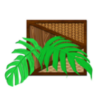Family Name
FLAGELLARIACEAE
Scientific Name
Flagellaria indica L.
Synonyms
Flagellaria philippinensis Elmer; Flagellaria minor Blume; Palminjuncus laevis Rumph.
Local Names
Anuad (Ilk.); arayan (Tag.); auai (Iv.); auai-si-gayang (Is.); baling-uai (Tag. Pamp.); boboaya (Mbo.); hoag-oai (Bik.0; huay (S.L. Bis Mbo.); huak (Bis.); ingual (Ilk); ingula (Tag.); inual (Pamp.); kala-uai (Ibn.); kala-uaiuai (Ibn.); ouag-oai (Bik.); ouag-ouag (Mbo.0 paua (P. Bis.); sagakap (P. Bis.); Taua (P. Bis.); tinuung (Ibn.); uag (Sul, Bis, Bag., Bik.); uai-ti-uak (Ilk.); uak (Bis.); neneg-aiang (Is.)
Botanical Description
A scrambler and leaf climber. Stem 1 cm or more in diameter, striated, glabrous, woody at the base, rarely branched, with distinct nodes and internodes. Leaves distichously alternate, simple, sessile, entire, oblong to linear, apex cirrhose (ending in coiled tendril), base rounded; lamina up to 48.4 cm long and 6.6 cm broad, glabrous; leaf sheath terete, enclosing the nodes; venation unicostate parallel. Inflorescence in panicles. Flowers apetalous, bisexual; tepals erect, oval rounded, thinly membranous, white, 2-23/4 mm long; stamens and stigmas finally far exserted. Fruit a pyrene, globose, ca. 6mm in diameter, pink and 2-seeded.
Distribution Ecology
Tropical Africa, Sri Lanka, tropical Southeast Asia throughout Malesia to North Australia, Melanesia and Polynesia. Throughout the Philippines from Bataan Islands to Palawan and Mindoro. Usually found in forest borders, along forest roads and disturbed open forests up to 1500 m altitude. Flowering and fruiting from January to December.
Other Economic Uses
The leaves contain flavonol glucosides. These are also used in making hair wash and as astringent and vulnerary. Stem and rhizome decoction serve as diuretic. The stem covering is used foe tying to reinforce bamboo fences and anahaw roof.
Volume Estimate
In Quezon, 1.87lm /ha and in the Bicol region, 13lm/ha.

